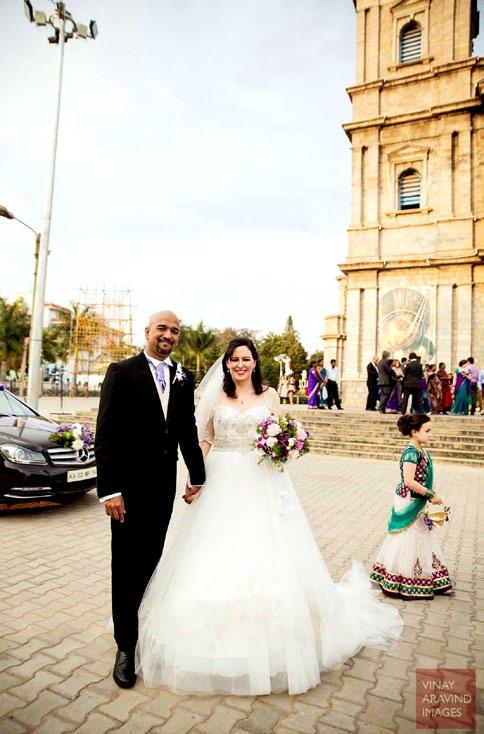
3 minute read
India
from 2023-06 Sydney
by Indian Link
felt like an idiot. The rest of the group were Indian, and they would be answering questions about history, literature, music, science, geography, and the only questions I knew the answers to were TV related or ‘80s rock (occasionally biology).
I knew more about different cuisines (other than Indian) than Indians. My husband is very passionate about food and we have several friends who are chefs who are all far more knowledgeable than me about food. There's lots of fine dining restaurants in Bangalore and lots of locals patronizing them.


Most Indians are Hindu and I wouldn’t come across many Christians. Hinduism is the most common religion in India, but there are lots of Muslims, Catholics and Protestants (and other religions too). The churches are huge and packed every week and especially during Easter and Christmas. There's a bakery which makes hot cross buns and sells out each Easter. The Catholic Club in Bangalore is wellknown for its events such as Christmas dances. I even got married in a cathedral in Bangalore!
All Indian food is spicy and everyone likes spice. I just had lunch at my husband’s aunty’s place and one of the dishes was too spicy for his (Indian) uncle! It’s quite common to meet Indians who don't like their food spicy. I think there's a misconception around the interpretation of “spice”. Cinnamon is a spice. It’s used in hot cross buns, but I don't think many people would call hot cross buns spicy. Indian cooking commonly uses spices but that doesn't mean the food burns your mouth. So my interpretation of the word spicy now means “gives flavour” rather than “burns my mouth” or “hot”.
I would easily be able to order butter chicken from any Indian restaurant. To find butter chicken in Bangalore, I’d have to go to a restaurant that serves northern Indian food! India's food is so diverse that even within one state there are different regions with very different food. In Karnataka alone, Coorg has its own special dishes like bamboo pickle and pandhi curry (pork curry); Mangalore has coconut dishes like fish curry; Mysore has dishes like Mysore pak and Mysore masala dosa. And that’s just one state. Imagine the diversity of dishes across the 29 states of India. Everyone likes cricket. There are a lot of Indians that like cricket for sure. As soon as I said I was Australian, people would go“Oh Ricky Ponting, madam!” But not everyone likes cricket, in fact the national sport of India is hockey. There are a LOT of people who like football, in fact that there is a statue of Pele (the famous football player) in Bangalore, next to a statue of Mother Teresa!
Nee RU S ALUJA
Within the first 15 minutes of listening to the audible Desi Down Under, you are transported from bustling Mangalore to the calm and crystal-clear waters of Coogee Beach.
Soon, you embark on a journey with three 20-year-old childhood friends who cross the ocean to learn surf-lifesaving skills in Sydney. It’s their first trip abroad, so while training as lifesavers they are also set to explore their freedom, dreams, desires and the nightlife of Sydney!
Desi Down Under, written by IndianAussie screenwriter Mithila Gupta (of Network 10’s Five Bedrooms fame) wanted to illustrate her love for India and Australia by telling a joyous story about Indians in Australia. It is also inspired by Partha Varanashi, Director of Surf Life Saving, India, whose mission is to make Indian beaches safer.
From this love, the concept for the podcast Desi Down Under was born. “The concept started 4 years ago,” Mithila tells Indian Link. “The producer Mala Sujan and I were keen to create something that will cut to both territories, India and Australia. I started writing, and pitched it to Audible Australia and they loved it. They shared it with the Indian team and they loved it, saying it’s been written Bollywood style! I started writing the episodes with the teams from Audible in India and Australia. They then got Mantra from MnM Talkies onboard and finalised Prajakta Koli, Adarsh Gourav and Taaruk Raina as actors.”
Mithila claims she also wanted to challenge expectations of Indians’ abilities to swim. To achieve this, she created nuanced characters with unique identities that we don’t often see represented in the media.

So what is the message people in India and Australia will take home?
“That despite our differences, we have more in common than what sets us apart,” replies Mithila.“That we are all human, complex, resilient beings, and we have a lot to learn and a lot we can teach each other. I’ve always wanted to explore the Indian-Aussie culture clash and fusion through comedy. A robust sense of humour is certainly something that both culture have in common!”
It is a thought that resonates with Prajakta Koli, one of the actors.
“The show is about love, family friendships, trying new things… but at the core of it, it’s about how similar we are as people – the primal instinct of survival, and being there for each other.”
The podcast was recorded live in Australia and India, and the cast of actors spans both countries. Jyotsna Sharma, the Executive Producer was the casting director for Australia and Pankaj Upadhayay (Euphony Films) was the cinematographer in Australia. Indian Aussie actors Ananya









